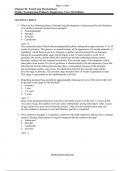Exam (elaborations)
Test Bank For Neonatal and Pediatric Respiratory Care 5th Edition Walsh 9780323479479 | All Chapters with Answers and Rationals
- Course
- Institution
- Book
Test Bank For Neonatal and Pediatric Respiratory Care 5th Edition Walsh 9780323479479 | All Chapters with Answers and Rationals . Instant Delivery .
[Show more]



